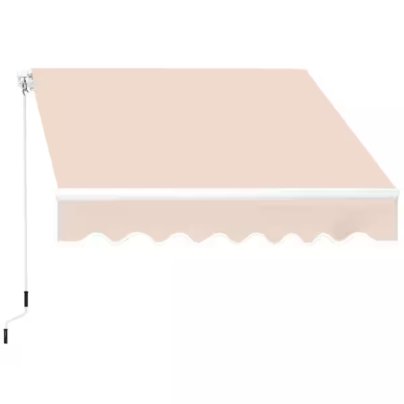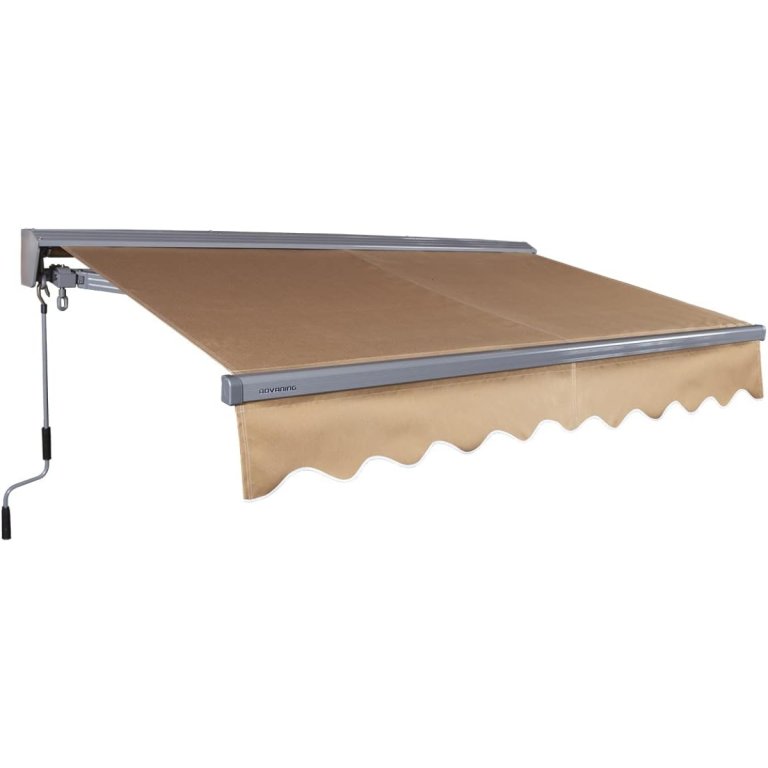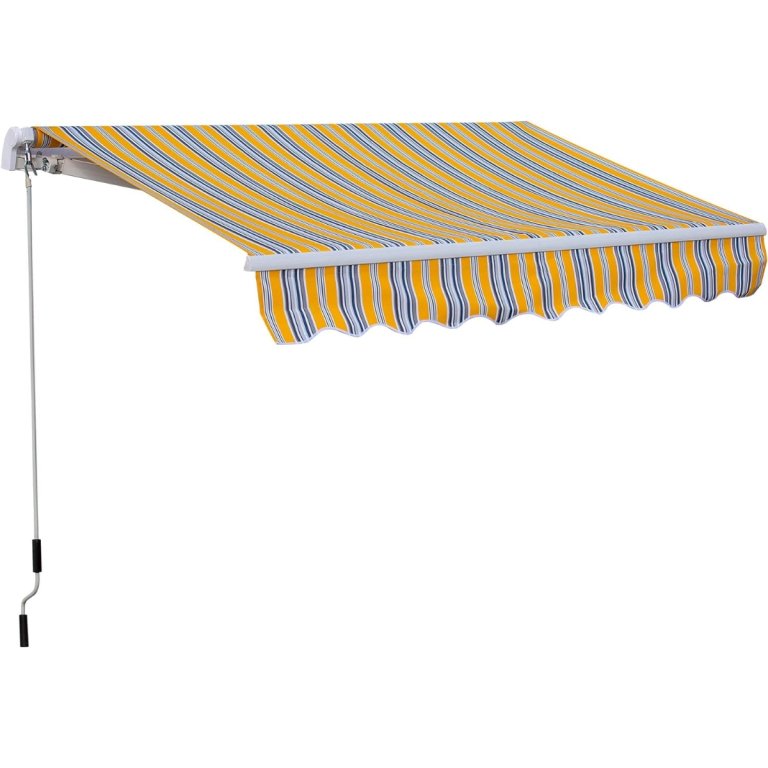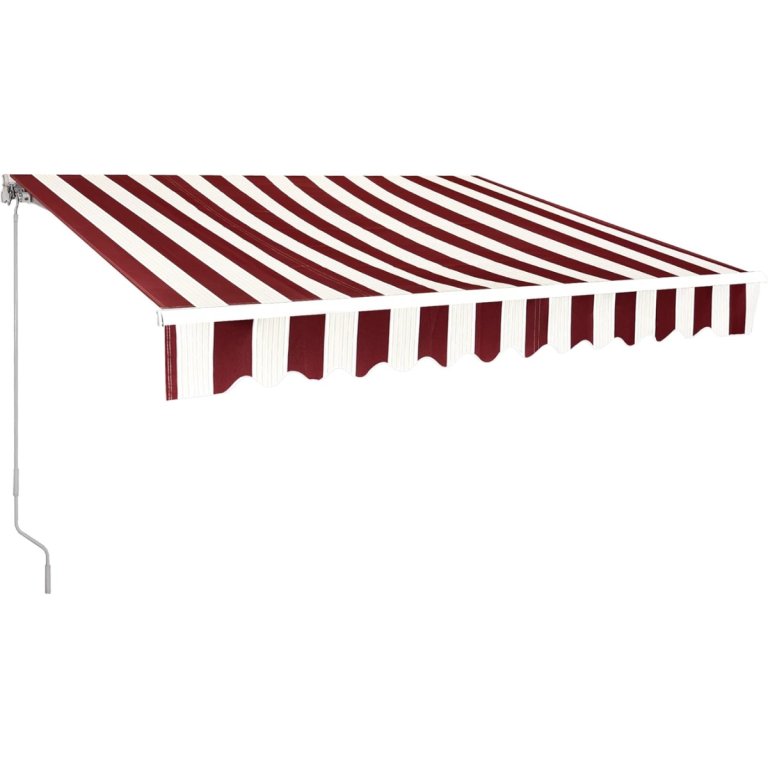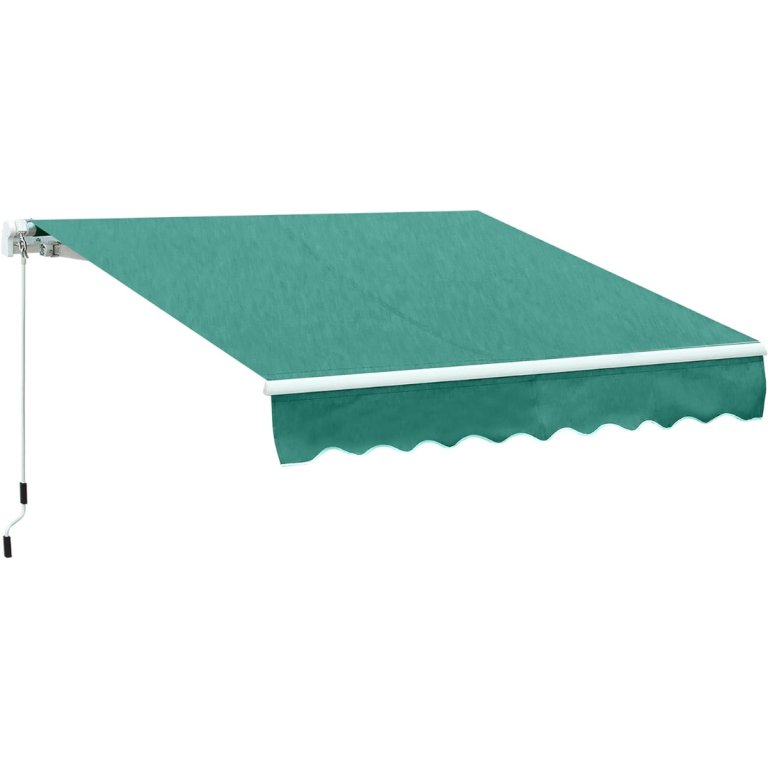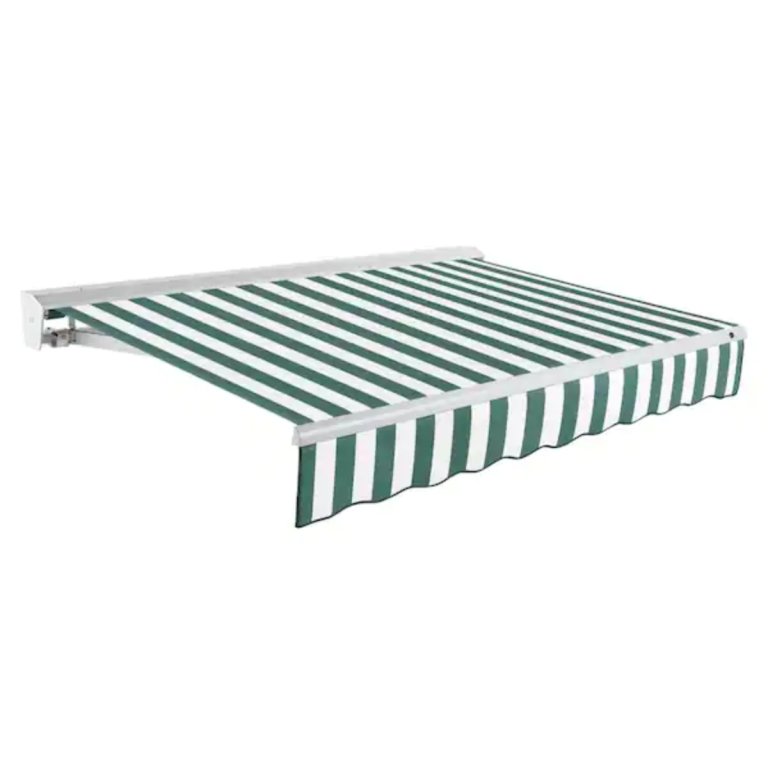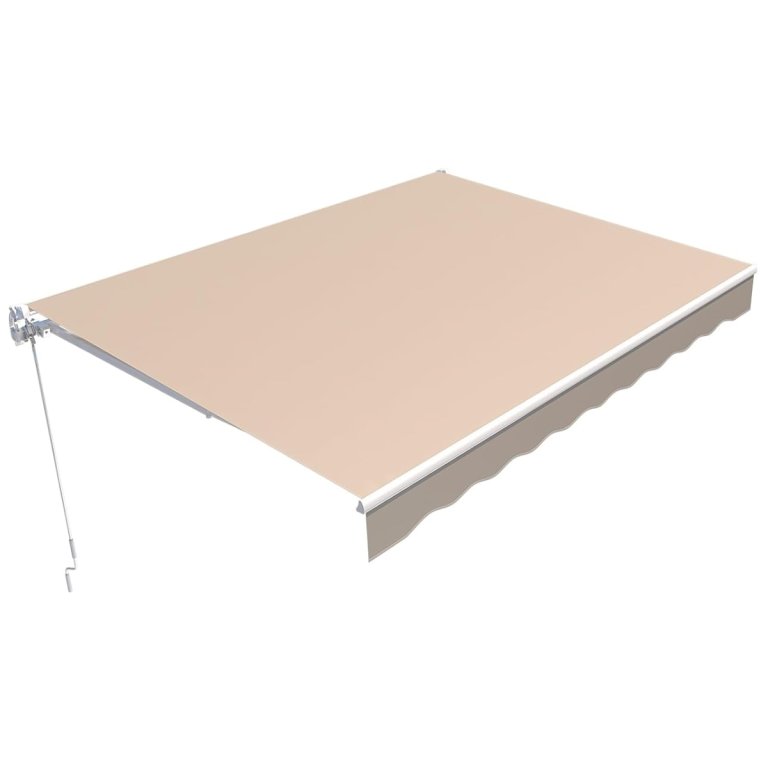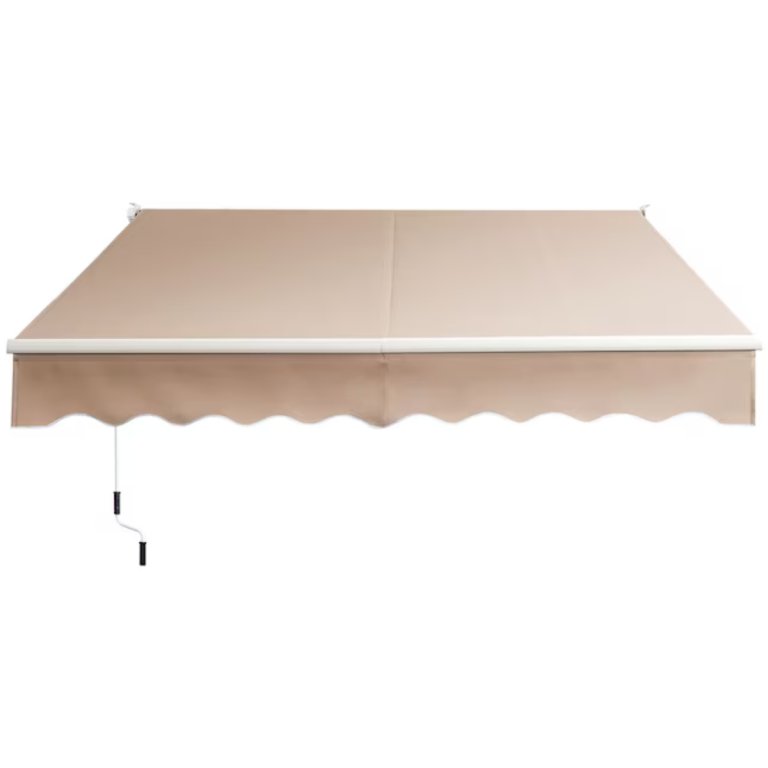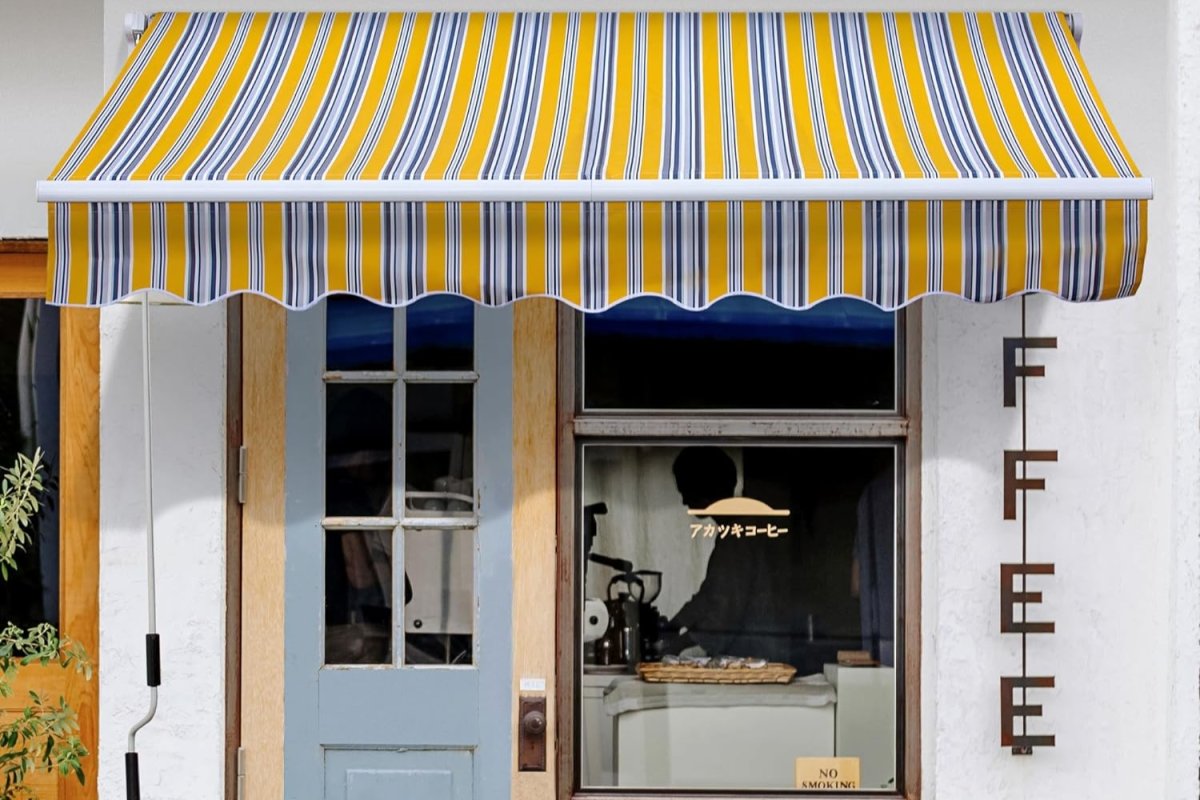
We may earn revenue from the products available on this page and participate in affiliate programs. Learn More ›
On sunny days, a retractable awning provides just the sun protection and shade you need on your porch, patio, or deck. Installing shade sails or awnings adds a charming visual and immediate curb appeal to your home, too. For added flexibility, consider a retractable awning. When not in use, retractable awnings tuck away so you can save space, protect the awning and enjoy the sunshine.
The best retractable awnings should be protective, durable, and easy to use. We rounded up a list of the best awnings for a variety of needs. Read on to learn more about the features to look for when selecting the best retractable awning and peruse our top picks in each category.
- BEST OVERALL: Advaning Classic Series Manual Retractable Awning
↓ Jump to Review - BEST BANG FOR THE BUCK: Veikous Manual Patio Retractable Awning
↓ Jump to Review - UPGRADE PICK: Advaning Classic Series Electric Retractable Awning
↓ Jump to Review - BEST MOTORIZED: Awntech Key West Motorized Retractable Awning
↓ Jump to Review - BEST SMALL: Outsunny Retractable Patio Awning
↓ Jump to Review - BEST LARGE: MCombo Manual Retractable Patio Window Awning
↓ Jump to Review - BEST FOR RAIN: Outsunny Manual Retractable Awning Sun Shade
↓ Jump to Review - BEST HEAVY-DUTY: Awntech Destin Manual Awning With Protective Hood
↓ Jump to Review - BEST UV PROTECTION: Aecojoy Manual Retractable Awning
↓ Jump to Review - BEST ADJUSTABLE: Costway Manual Retractable Patio Awning
↓ Jump to Review
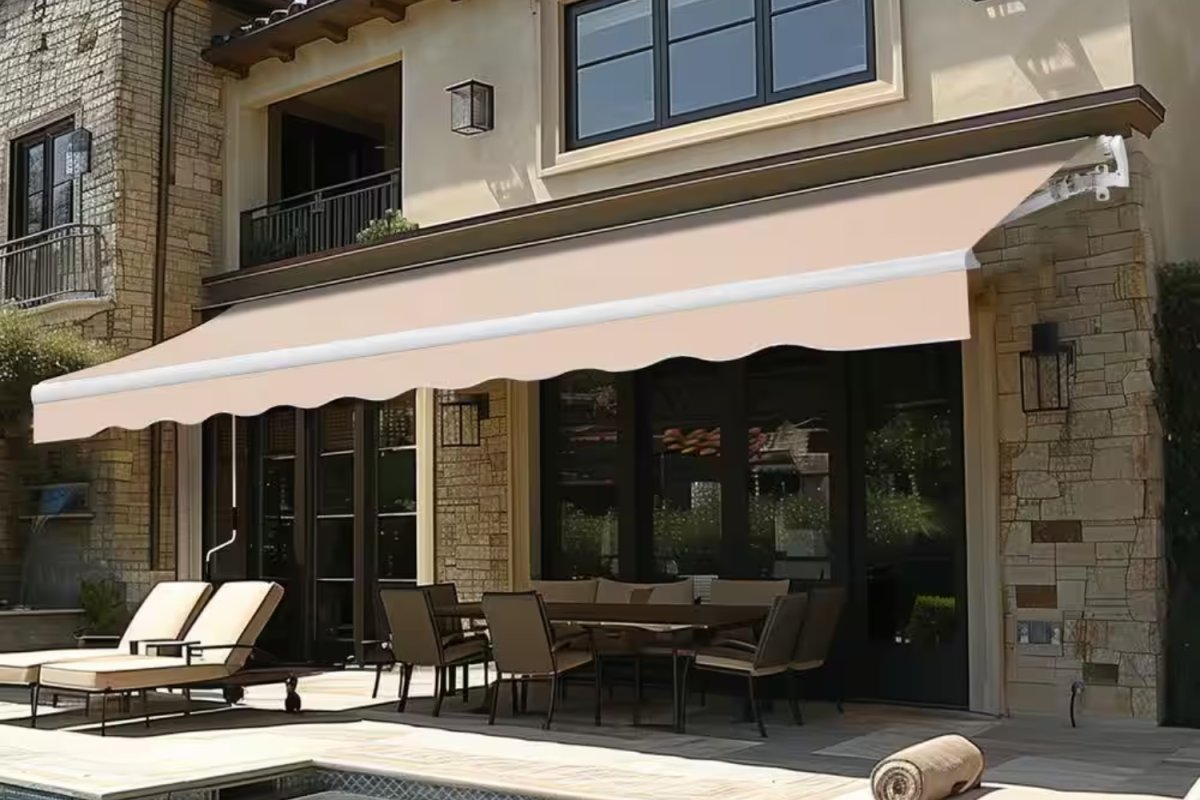
How We Chose the Best Retractable Awnings
Retractable awnings for patios serve a couple of functions: to protect from the sun and add an attractive design element to your home’s exterior. When researching the best retractable awnings, we kept both functions in mind.
It takes a bit of work and time to install an awning, so it’s important to find one that will last. We looked for awnings made of high-quality and durable materials to handle outdoor conditions (rain or shine). We looked for a sturdy frame to support the awning, even in strong winds, and tough fabric that both protects against the sun and resists fading, dirt and mildew. We evaluated durability through product research and by taking into account user reviews, which give a good idea of real-world performance.
We also considered design. Awnings draw attention to themselves, so they need to look attractive. Awnings with several colorways and patterns earned bonus points. To appeal to a wider range of shoppers, we looked for awnings that came in classic colors and designs.
Our Top Picks
A well-placed retractable awning creates comfortable and shady patio space and shields outdoor space from the sun’s harsh glare. We’ve selected the following retractable awnings to represent the best in durability, ease of use, and great sun protection.
Best Overall
Advaning Classic Series Manual Retractable Awning
What We Like
- Easy angle adjustment can provide custom shade coverage; can be adjusted from
- High-quality stainless steel and acrylic build is durable
- Aesthetically pleasing design available in multiple sizes and colors
- Arrives preassembled; no fiddling with small parts and complex assembly
What We Don’t Like
- More durable materials and higher-quality fabric make this option quite pricey
- Manufacturer does not list the range in which the pitch angle can be adjusted
Product Specs
- Extending mechanism: Manual
- Size: 12 feet wide by 10 feet deep
- Material: Stainless steel and aluminum frame, acrylic canopy
An excellent retractable awning can add to a home’s curb appeal, which makes it worth a little extra money. And a well-made awning, like Advaning’s Classic Series awning, will last for years.
The classic awning measures 12 feet wide by 10 feet deep. Advaning’s premium 100 percent acrylic fabric offers a few advantages over cheaper awning fabrics. It provides UV80+ sun protection to guard against strong ultraviolet (UV) rays. Highly breathable, it won’t trap in warm air or moisture like some polyester and vinyl awnings might.
A durable powder-coated stainless steel frame keeps the awning solid, even in windy weather. This awning features a manual extending mechanism and an easy pitch system that makes it simple to adjust the angle.
Get the Advaning manual retractable awning at Amazon, Lowe’s, The Home Depot, Wayfair, or Appliances Connection.
Best Bang For The Buck
Veikous Manual Patio Retractable Awning
What We Like
- Made with rust-resistant aluminum metal supports and arms that stand up to harsh weather
- Fabric canopy is waterproof, UV-resistant, and resists color fading; comes in gray and beige
- Adjustable slope angle helps users customize shade coverage to their needs
What We Don’t Like
- Limited color choices available relative to similar brands
Product Specs
- Extending mechanism: Hand crank
- Size: 10 feet wide by 8 feet deep
- Material: Aluminum and steel frame, polyester canopy
With a heavy-duty fabric canopy and durable frame, the Veikous retractable awning makes a durable pick. It features a lightweight powder-coated aluminum frame with steel supporting tubes and a polyester fabric canopy, all of which withstand wind speeds of up to 30 miles per hour. The fabric also resists water and fading while blocking out 30+ UV rays and adding a pop of color to a patio, balcony, or deck. A notable feature of this retractable awning is that the slope is adjustable from 45 to 85 degrees, which can help you customize the shade coverage required for an area.
Veikous’ midsize manual retractable awning measures 10 feet wide by 8 feet deep to provide shady coverage for a seating area or patio set. A smooth-operating manual crank handle allows you to retract or extend the awning for use in mild weather conditions. Included installation hardware allows for setup on stucco, vinyl siding, or wood.
Get the Veikous retractable awning at The Home Depot or Veikous.
Upgrade Pick
Advaning Classic Series Electric Retractable Awning
What We Like
- Remote operated and easy to use; no manual cranking required
- Adjustable awning angle can help cast shade where it’s needed
- Backup manual crank handle is useful in a pinch, such as during power outages
What We Don’t Like
- Requires an accessible power source to operate the motorized mechanism
Product Specs
- Extending mechanism: Motorized
- Size: 8 feet wide by 7 feet deep
- Material: Aluminum and steel frame, acrylic canopy
Shoppers looking to automate their backyard shade may want to consider Advaning’s motorized patio awning, which makes a hassle-free pick for a small patio or balcony. Measuring 8 feet wide by 7 feet deep, it features a durable steel and aluminum frame and a premium acrylic canopy. Sturdy acrylic fabric guards against UV rays, fading, and water. The breathable material won’t trap hot air inside on sunny days. With several color options and stripe patterns to choose from, this automated awning can add a decorative touch to an outdoor area.
This convenient awning extends or retracts with the click of a button on the remote control. Advaning’s Easy Pitch system makes it simple to adjust the pitch of the canopy once installed. In case of any trouble with the motor, switch to the manual crank for easy operation.
Get the Advaning electric retractable awning at Amazon, Lowe’s, The Home Depot, or Appliances Connection.
Best Motorized
Awntech Key West Motorized Retractable Awning
What We Like
- Can operate both as a manual or an electric awning depending on individual users’ needs
- Available in multiple sizes and colors; can match most existing patio furniture
- Durable construction is sturdy enough to withstand 30-mile-per-hour (mph) winds
What We Don’t Like
- A significant investment compared to some other cheaper options
- This sturdy and heavy model can only be mounted to wall surfaces
Product Specs
- Extending mechanism: Electric
- Size: 12 feet wide by 12 feet deep
- Material: Powder-coated steel, aluminum, and dyed acrylic canopy
To reduce hand fatigue, the Awntech Key West retractable awning for decks and patios is completely electric, making retracting and expanding hands-free. Made with powder-coated steel and aluminum, this awning is very durable and withstands 30 mph winds. The dyed acrylic fabric is made by Beauty-Mark and comes in over 18 colorways. Plus, it comes fully assembled.
This retractable sun shade comes in a 12-foot-wide by 12-foot-deep size but can also be purchased in depths of 8 to 24 feet to cover patios, barbecue areas, and walkouts. For versatility, this model comes with an additional hand crank for manual use and a remote control for controlling the awning’s retraction and expansion. The only downside of this product is that it can only be mounted to wall surfaces.
Get the Awntech Key West retractable awning at The Home Depot or Lowe’s.
Best Small
Outsunny Retractable Patio Awning
What We Like
- Polyester canopy fabric offers solid protection from UV rays and withstands wind up to 20 mph
- Aluminum and steel frame is durable and weather-resistant; can hold up to 1 pound of snow
- Easy to install with predrilled holes and included mounting hardware
- Smaller size is versatile for placing over doorways or windows
What We Don’t Like
- Does not include adequate mounting hardware for wood-framed homes
Product Specs
- Extending mechanism: Manual
- Size: 8 feet wide by 7 feet deep
- Material: Aluminum and steel frame, polyurethane-coated polyester canopy
To cover a small deck, balcony, or set of sliding doors, consider Outsunny’s manual retractable awning. An aluminum and steel frame and a polyurethane-coated polyester fabric canopy form a sturdy UV-protective, water-resistant awning that shields users from the sun year-round. At 8 feet wide by 7 feet deep, it provides excellent coverage over patio doors or a bay window to reduce heat and damaging UV rays. A striped pattern with decorative trim adds charm to windows and doors.
A manual hand crank allows users to adjust the projection and angle to create more or less shade as needed. Included installation hardware allows for mounting on vinyl siding or stucco. Users can add mounting screws for installation onto wood-framed homes.
Get the Outsunny retractable awning at Amazon or Wayfair.
Best Large
MCombo Manual Retractable Patio Window Awning
What We Like
- Features an adjustable tilt angle up to 35 degrees; can follow the sun as it moves
- Includes installation hardware for various wall types; can be installed on concrete, wood, and brickwork
- Provides a large coverage area; great for big patio spaces
What We Don’t Like
- Plastic hand crank may not last as long as the rest of the awning
Product Specs
- Extending mechanism: Manual
- Size: 12 feet wide by 10 feet deep
- Material: Aluminum frame, polyester canopy
Measuring 12 feet wide by 10 feet deep, MCombo’s manual awning provides ample coverage from the sun and light rain. A lightweight but sturdy corrosion-resistant, powder-coated aluminum frame supports a large, polyurethane-coated polyester fabric canopy. The material resists water, UV rays, and fading and stands up to winds of up to 18 mph. Plus, it comes in multiple color options to suit any buyer’s backyard.
A simple hand-crank mechanism easily retracts the outdoor awning after each use. Included installation hardware facilitates setup on concrete, wood, or brick walls.
Get the MCombo retractable awning at Amazon or MCombo.
Best For Rain
Outsunny Manual Retractable Awning Sun Shade
What We Like
- Sturdy design with smooth and quiet hand-crank operation; made with durable aluminum and steel
- Water-resistant canopy easily stands up to rainfall; ideal in wetter climates
- Available in several attractive color options; can suit most backyard styles
What We Don’t Like
- Not intended for constant heavy rain; fabric can deteriorate more quickly
Product Specs
- Extending mechanism: Manual
- Size: 10 feet wide by 8 feet deep
- Material: Aluminum and steel frame, polyester canopy
With a reinforced frame and water-resistant canopy, Outsunny’s awning provides year-round protection. Measuring 10 feet wide by 8 feet deep, it makes an excellent pick for patios and decks or large windows and doors.
A durable aluminum and steel frame and a sturdy polyester canopy provide long-term, year-round use. Brown polyurethane-coated fabric forms a shield against water and UV rays. While always best to retract the awning in adverse weather conditions, this water-resistant awning protects from light rain and surprise summer showers.
A manual hand crank allows users to adjust canopy coverage length to meet the different sun and shade needs. Included installation hardware allows for mounting on a concrete wall. Users may add hardware to mount to stucco, siding, or wood.
Get the Outsunny manual retractable awning at Amazon.
Best Heavy-duty
Awntech Destin Manual Awning With Protective Hood
What We Like
- Available in wide range of sizes, colors, and manual or motorized awnings
- Protective hood helps keep the fabric out of the elements when retracted
- Housing and mechanism looks neat and sleek compared to more standard awnings
What We Don’t Like
- Both the manual and motorized versions are quite pricey due to the high durability
Product Specs
- Extending mechanism: Manual
- Size: 12 feet wide by 10 feet deep
- Material: Aluminum and steel frame, acrylic canopy
Heavy-duty awnings make a great pick for most homes and an especially prudent choice for those in windy areas. Awntech’s Destin manual retractable awning withstands winds of up to 35 mph and stays put through storms. It is also available as either a manual or a motorized crank type, with a convenient choice between mounting the motor on the left or the right side.
The awning’s durability comes from its materials. Mounted on a powder-coated steel and aluminum frame, it features solution-dyed 100 percent acrylic fabric that holds up against fading, mildew, and dirt. A hood protects the awning and keeps out debris when not in use. This awning features adjustable pitch options.
Awntech’s awning comes in several sizes and colors, including this 12-foot-wide by 10-foot-deep model in green and white stripes.
Get the Awntech Destin retractable awning at The Home Depot (manual) or the full selection at Wayfair or Awntech.
Best Uv Protection
Aecojoy Manual Retractable Awning
What We Like
- Polyester fabric comes with 30 UV+ solar protection and is fade- and water-resistant
- Aluminum and double-strand steel rope allow for long-term use; withstands winds of up to 30 mph
- Comes in multiple sizes and color options to suit multiple buyers’ outdoor spaces
What We Don’t Like
- The manufacturer recommends installing this unit high above a door frame; the manual handle may be hard to access
Product Specs
- Extending mechanism: Manual
- Size: 8 feet wide by 10 feet deep (multiple sizes offered)
- Material: Powder-coated aluminum frame, polyester fabric, and steel rope
Those with sensitive skin or who spend a lot of time on a patio can benefit from some added sun protection with this high-quality retractable awning from Aecojoy. It’s made from polyester fabric that provides 30 UV+ solar protection while also being fade- and water-resistant.
This 8-foot-wide by 10-foot-deep awning has a lightweight, powder-coated, rust-resistant aluminum construction that withstands wind speeds of up to 30 mph. Plus, it has retractable mounting brackets and a double-strand steel rope for long-term retraction and expansion.
The angle of the awning can also be adjusted from 40 to 90 degrees depending on the given outdoor space. This manual crank awning comes in four different sizes and color options to suit a given user’s patio or backyard space.
Get the Aecojoy retractable awning at Amazon.
Best Adjustable
Costway Manual Retractable Patio Awning
What We Like
- The angle of the awning can be adjusted between 40 and 100 degrees; can be adjusted as the sun moves
- Made with a yarn-dyed and waterproof polyester fabric and a rust-resistant aluminum alloy frame
- Opens and closes in under a minute with an easy-to-use manual hand crank
What We Don’t Like
- Requires some assembly before installation; may be tricky for first timers
- Does not provide any significant mildew resistance
Product Specs
- Extending mechanism: Manual
- Size: 8 feet long by 10 feet deep
- Material: Aluminum alloy frame, yarn-dyed and polyacrylic-coated polyester
Adjustability may be the thing that matters most to some users when selecting an awning, which is why we recommend this model from Costway. This awning opens and closes in under a minute with the help of its long hand crank, and the angle of the awning can be adjusted between 40 to 100 degrees. The manufacturer states that this option can be mounted on either brickwork or cement.
This awning features a yarn-dyed, waterproof polyester with a polyacrylic coating for sun resistance as well as a rust-resistant aluminum alloy frame for long-term use and durability against the elements. The only downside to this option is that it is not mildew-resistant, which may be an issue for buyers in areas that experience frequent rain. This model also requires some assembly when being installed.
Get the Costway retractable awning at Lowe’s.
Jump to Our Top Picks
What to Consider When Choosing a Retractable Awning
A retractable awning shades an outdoor living space without the need for a separate or permanent structure. Awnings also reduce light and heat over doors and windows to help lower indoor temperatures. When selecting the best retractable awning, consider the design, material, size, installation process, and any additional convenience features. Shoppers will find a number of sizes and designs to choose from.
Extending Mechanism
Retractable deck awnings come in both manual and automatic models. Both options protect users from the elements. Consider cost and ease of use when choosing between the two.
Most manual awnings rely on a pulley and cord system. A simple manual crank handle opens and closes the extending mechanism. Admittedly less convenient, manual-crank awnings tend to come in at a lower price and allow for easier repair. As manual awnings don’t require a power supply, you have more options for where to install them.
In an automatic or motorized patio retractable awning, the extending mechanism runs on a motor that opens and closes the awning automatically. These more convenient awnings come at a higher price than their manual counterparts. Repairs tend to cost more, too. And they require a power supply. For the extra cost, however, you may get a range of convenient features like remote control operation and automatic sensors.
Fabric
Patio awnings, like most outdoor curtains, come in a range of fabrics that withstand the elements, reduce glare and block out UV rays. They also tend to resist water, whether naturally or through a waterproof coating like polyurethane (PU), so rain won’t destroy them.
Common canopy fabrics used in outdoor shades, awnings, and curtains include canvas, polyester, PVC, and acrylic. Here’s what you should know about each:
- Canvas: Flexible, natural, and affordable, classic canvas awnings come in a range of fun patterns and colors. While durable, canvas may fade or mildew with weather exposure. To prevent these outcomes, look for canvas canopies coated with protective solutions.
- Polyester: A flexible synthetic, water-resistant, lightweight polyester stands up to weather, time, and mildew at an affordable price.
- Polyvinyl chloride (PVC): Another popular synthetic, PVC provides excellent water resistance. Easy to clean, it tends not to mold or mildew. However, its lower tensile strength makes it more prone to rips and tears.
- Acrylic: Durable acrylic tends to resist weather, mildew, and fading. Among the options, shoppers will find acrylics, such as Sunbrella, designed specifically for outdoor use.
Frame Material
Most retractable awnings have metal frames. Nonporous, sturdy metal frames handle wet and windy weather conditions well. Protective treatments like powder coating ensure the frames remain rust-free for years. Metal comes in a range of colors, most commonly black, gray, and white.
Aluminum and steel, the two most common metal options, each has pros and cons. Budget-friendly, lightweight aluminum is strong but perhaps not as strong as steel. Pricier steel weighs a good bit more but lasts longer, too.
Size
An awning shouldn’t obstruct or crowd the patio or deck. Its dimensions must fit the intended area. Consider the width and the projection of the awning, and make sure there is enough vertical space for installation.
The width refers to the dimension of the wall-mounted side. To choose a suitable width, consider the wall area you want to cover and make sure there are no obstructions. Awnings can range upward of 15 feet wide, and two or more awnings can be paired together for more coverage.
An awning’s projection refers to how far it extends from the wall. The farther the projection, the more shade it provides. Awnings can project from 5 to more than 10 feet. Take note, however, that wider models put more pressure on the installation mount. Keep in mind the awning projection refers to the top of the canopy, which does include the installation pitch (the angle of the awning slope).
Installation
Retractable awnings mount to the exterior wall, soffit, or roof of a home. DIY retractable awning kits include instructions for installation, but make sure the awning includes the necessary installation hardware. Enlist a partner to help you. Awning installation is at least a two-person job.
The installation method depends on the wall where you’ll mount the awning. Different surfaces, such as brick, stucco, cement, and vinyl, require different anchoring methods. Follow the directions provided by awning companies for safe and proper installation. When in doubt, consider hiring professional help to install the awning. A secure installation makes a worthwhile investment for years of sun coverage.
Additional Features
Motorized retractable awnings include a range of convenient features, such as weather sensors, operation by app or remote control, timers, and heaters. Some motorized retractable awnings include handy sensors that can measure moisture levels, wind strength, and brightness. These automatically trigger the canopy to extend or retract depending on the conditions.
For convenience, some retractable patio awnings offer remote or smartphone control. Remote controls, the lower-tech option, offer users control of the awning from anywhere on the patio. Higher-tech, smart options offer users control from longer rangers through a phone app. These allow users to operate a range of features, including extending and retracting the awning, setting timers, and adjusting automatic program settings.
Awning heaters help create a winterized covered area and provide some heat on cool but sunny winter days.
FAQs
Retractable awnings give you control of sun exposure and shade, so you can make the most of your outdoor living space. These versatile products retract to let in the morning sun and then open to protect against harsh midday rays. Consider the following commonly asked questions and answers when selecting your retractable awning.
Both options protect from the sun; the right one for your space depends on personal preference and budget. Automatic retractable awnings are convenient. They extend or retract at the press of a button but that convenience comes at a higher price. Manual retractable awnings cost less, but they require manual opening and closing with each use.
Yes, you can install your retractable awnings. Make sure to have at least one helping partner on hand and follow the manufacturer’s directions for safe installation.
Yes, a retractable sun shade awning can be used in light rain, but keep in mind that most aren’t made to withstand stormy conditions. Heavy rain and snow can weigh down and damage an awning, so make sure to retract the awning in bad weather.
Retractable awnings can handle light wind, but most aren’t made to withstand very windy weather. If the wind makes it uncomfortable to sit outside, that’s a sign that it’s time to retract the awning. Many models tolerate winds up to 25 miles per hour.

